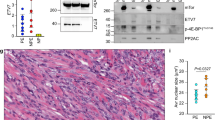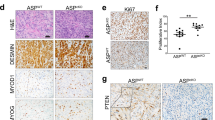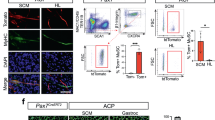Abstract
Embryonal rhabdomyosarcoma (ERMS) is a tumor of the skeletal muscle in children and is frequently initiated by heterozygous germline mutations in the Hedgehog (Hh) receptor Patched1 (Ptch), both in humans and mice. Using a conditional knock-out strategy in Ptchflox/+ mice, we demonstrate that early embryonic stages are more susceptible to ERMS development than later stages and that cells normally not committed to undergo myogenesis at this stage represent the major source of ERMS. We found that deletion of a single copy of the Ptch allele at E9.5 using the ubiquitously active Rosa26CreERT2 resulted in a tumor incidence of 88% but reached only 44% and 12% when the Ptch allele was inactivated at E11.5 and E13.5, respectively. Induction of the Ptch mutation at E9.5 did also significantly shorten ERMS-free survival and increased tumor multiplicity compared with tumor induction at E11.5 and E13.5. Interestingly, we observed a more that 10-fold reduction of ERMS incidence when the Ptch mutation was specifically introduced in Myf5-expressing cells, which is the myogenic factor expressed in all muscle cells at E9.5. We conclude that Myf5-negative cells are more susceptible to ERMS development than Myf5-positive embryonic precursors. As the propensity to undergo tumorigenic transformation declined with age, concomitant with the increase of stably committed muscle cells, it seems likely that the Ptch mutation favors tumor formation in progenitor cells, which have not yet acquired a muscle cell fate.
This is a preview of subscription content, access via your institution
Access options
Subscribe to this journal
Receive 50 print issues and online access
$259.00 per year
only $5.18 per issue
Buy this article
- Purchase on Springer Link
- Instant access to full article PDF
Prices may be subject to local taxes which are calculated during checkout




Similar content being viewed by others
References
Asakura A, Tapscott SJ . (1998). Apoptosis of epaxial myotome in Danforth's short-tail (Sd) mice in somites that form following notochord degeneration. Dev Biol 203: 276–289.
Biressi S, Molinaro M, Cossu G . (2007a). Cellular heterogeneity during vertebrate skeletal muscle development. Dev Biol 308: 281–293.
Biressi S, Tagliafico E, Lamorte G, Monteverde S, Tenedini E, Roncaglia E et al. (2007b). Intrinsic phenotypic diversity of embryonic and fetal myoblasts is revealed by genome-wide gene expression analysis on purified cells. Dev Biol 304: 633–651.
Braun T, Bober E, Rudnicki MA, Jaenisch R, Arnold HH . (1994). MyoD expression marks the onset of skeletal myogenesis in Myf-5 mutant mice. Development 120: 3083–3092.
Braun T, Rudnicki MA, Arnold HH, Jaenisch R . (1992). Targeted inactivation of the muscle regulatory gene Myf-5 results in abnormal rib development and perinatal death. Cell 71: 369–382.
Calzada-Wack J, Kappler R, Schnitzbauer U, Richter T, Nathrath M, Rosemann M et al. (2002). Unbalanced overexpression of the mutant allele in murine Patched mutants. Carcinogenesis 23: 727–734.
Danielian PS, Muccino D, Rowitch DH, Michael SK, McMahon AP . (1998). Modification of gene activity in mouse embryos in utero by a tamoxifen-inducible form of Cre recombinase. Curr Biol 8: 1323–1326.
Diwan BA, Anderson LM, Ward JM . (1997). Proliferative lesions of oviduct and uterus in CD-1 mice exposed prenatally to tamoxifen. Carcinogenesis 18: 2009–2014.
Ecke I, Petry F, Rosenberger A, Tauber S, Monkemeyer S, Hess I et al. (2009). Antitumor effects of a combined 5-aza-2′deoxycytidine and valproic acid treatment on rhabdomyosarcoma and medulloblastoma in Ptch mutant mice. Cancer Res 69: 887–895.
Evangelista M, Tian H, de Sauvage FJ . (2006). The hedgehog signaling pathway in cancer. Clin Cancer Res 12: 5924–5928.
Gensch N, Borchardt T, Schneider A, Riethmacher D, Braun T . (2008). Different autonomous myogenic cell populations revealed by ablation of Myf5-expressing cells during mouse embryogenesis. Development 135: 1597–1604.
Goodrich LV, Johnson RL, Milenkovic L, McMahon JA, Scott MP . (1996). Conservation of the hedgehog/patched signaling pathway from flies to mice: induction of a mouse patched gene by Hedgehog. Genes Dev 10: 301–312.
Gorlin RJ . (1987). Nevoid basal-cell carcinoma syndrome. Medicine (Baltimore) 66: 98–113.
Gustafsson MK, Pan H, Pinney DF, Liu Y, Lewandowski A, Epstein DJ et al. (2002). Myf5 is a direct target of long-range Shh signaling and Gli regulation for muscle specification. Genes Dev 16: 114–126.
Hahn H, Christiansen J, Wicking C, Zaphiropoulos PG, Chidambaram A, Gerrard B et al. (1996). A mammalian patched homolog is expressed in target tissues of sonic hedgehog and maps to a region associated with developmental abnormalities. J Biol Chem 271: 12125–12128.
Hahn H, Nitzki F, Schorban T, Hemmerlein B, Threadgill D, Rosemann M . (2004). Genetic mapping of a Ptch1-associated rhabdomyosarcoma susceptibility locus on mouse chromosome 2. Genomics 84: 853–858.
Hahn H, Wojnowski L, Zimmer AM, Hall J, Miller G, Zimmer A . (1998). Rhabdomyosarcomas and radiation hypersensitivity in a mouse model of Gorlin syndrome. Nature Med 4: 619–622.
Hameyer D, Loonstra A, Eshkind L, Schmitt S, Antunes C, Groen A et al. (2007). Toxicity of ligand-dependant Cre-recombinases and generation of a conditional Cre-deleter mouse allowing mosaic recombination in peripheral tissues. Physiol Genomics 31: 32–41.
Hooper JE, Scott MP . (2005). Communicating with Hedgehogs. Nat Rev Mol Cell Biol 6: 306–317.
Kappler R, Bauer R, Calzada-Wack J, Rosemann M, Hemmerlein B, Hahn H . (2004). Profiling the molecular difference between Patched- and p53-dependent rhabdomyosarcoma. Oncogene 23: 8785–8795.
Keller C, Arenkiel BR, Coffin CM, El-Bardeesy N, DePinho RA, Capecchi MR . (2004a). Alveolar rhabdomyosarcomas in conditional Pax3: Fkhr mice: cooperativity of Ink4a/ARF and Trp53 loss of function. Genes Dev 18: 2614–2626.
Keller C, Hansen MS, Coffin CM, Capecchi MR . (2004b). Pax3: Fkhr interferes with embryonic Pax3 and Pax7 function: implications for alveolar rhabdomyosarcoma cell of origin. Genes Dev 18: 2608–2613.
Kruger M, Mennerich D, Fees S, Schafer R, Mundlos S, Braun T . (2001). Sonic hedgehog is a survival factor for hypaxial muscles during mouse development. Development 128: 743–752.
Langenau DM, Keefe MD, Storer NY, Guyon JR, Kutok JL, Le X et al. (2007). Effects of RAS on the genesis of embryonal rhabdomyosarcoma. Genes Dev 21: 1382–1395.
McDermott A, Gustafsson M, Elsam T, Hui CC, Emerson Jr CP, Borycki AG . (2005). Gli2 and Gli3 have redundant and context-dependent function in skeletal muscle formation. Development 132: 345–357.
Merlino G, Helman LJ . (1999). Rhabdomyosarcoma--working out the pathways. Oncogene 18: 5340–5348.
Merlino G, Khanna C . (2007). Fishing for the origins of cancer. Genes Dev 21: 1275–1279.
Nagao K, Togawa N, Fujii K, Uchikawa H, Kohno Y, Yamada M et al. (2005). Detecting tissue-specific alternative splicing and disease-associated aberrant splicing of the PTCH gene with exon junction microarrays. Hum Mol Genet 14: 3379–3388.
Resende TP, Ferreira M, Teillet MA, Tavares AT, Andrade RP, Palmeirim I . (2010). Sonic hedgehog in temporal control of somite formation. Proc Natl Acad Sci USA 107: 12907–12912.
Rivera OJ, Cho MJ, Arenkiel BR, Milenkovic L, Capecchi MR, Scott MP et al. (2006). Medulloblastoma but not rhabdomyosarcoma in a conditional mouse model of Patched1 haploinsufficiency. Abstract no. 2742; 97th AACR Annual Meeting; 1–5 April 2006; Washington, DC.
Tallquist MD, Weismann KE, Hellstrom M, Soriano P . (2000). Early myotome specification regulates PDGFA expression and axial skeleton development. Development 127: 5059–5070.
Taniguchi E, Cho MJ, Arenkiel BR, Hansen MS, Rivera OJ, McCleish AT et al. (2009). Bortezomib reverses a post-translational mechanism of tumorigenesis for patched1 haploinsufficiency in medulloblastoma. Pediatr Blood Cancer 53: 136–144.
Tostar U, Malm CJ, Meis-Kindblom JM, Kindblom LG, Toftgard R, Unden AB . (2006). Deregulation of the hedgehog signalling pathway: a possible role for the PTCH and SUFU genes in human rhabdomyoma and rhabdomyosarcoma development. J Pathol 208: 17–25.
Uhmann A, Dittmann K, Nitzki F, Dressel R, Koleva M, Frommhold A et al. (2007). The Hedgehog receptor Patched controls lymphoid lineage commitment. Blood 110: 1814–1823.
Uhmann A, Ferch U, Bauer R, Tauber S, Arziman Z, Chen C et al. (2005). A model for PTCH1/Ptch1-associated tumors comprising mutational inactivation and gene silencing. Int J Oncol 27: 1567–1575.
Varjosalo M, Taipale J . (2008). Hedgehog: functions and mechanisms. Genes Dev 22: 2454–2472.
Yang ZJ, Ellis T, Markant SL, Read TA, Kessler JD, Bourboulas M et al. (2008). Medulloblastoma can be initiated by deletion of Patched in lineage-restricted progenitors or stem cells. Cancer Cell 14: 135–145.
Zibat A, Missiaglia E, Rosenberger A, Pritchard-Jones K, Shipley J, Hahn H et al. (2010). Activation of the hedgehog pathway confers a poor prognosis in embryonal and fusion gene-negative alveolar rhabdomyosarcoma. Oncogene 29: 6323–6330.
Zibat A, Uhmann A, Nitzki F, Wijgerde M, Frommhold A, Heller T et al. (2009). Time-point and dosage of gene inactivation determine the tumor spectrum in conditional Ptch knockouts. Carcinogenesis 30: 918–926.
Acknowledgements
We thank Susan Peter and Stefan Wolf for excellent animal care and Simone Fulda for critical comments on the manuscript. This work was supported by the grant 2003.112.3 of the Wilhelm Sander Stiftung to HH.
Author information
Authors and Affiliations
Corresponding author
Ethics declarations
Competing interests
The authors do not have a conflict of interest.
Additional information
Supplementary Information accompanies the paper on the Oncogene website
Supplementary information
Rights and permissions
About this article
Cite this article
Nitzki, F., Zibat, A., Frommhold, A. et al. Uncommitted precursor cells might contribute to increased incidence of embryonal rhabdomyosarcoma in heterozygous Patched1-mutant mice. Oncogene 30, 4428–4436 (2011). https://doi.org/10.1038/onc.2011.157
Received:
Revised:
Accepted:
Published:
Issue Date:
DOI: https://doi.org/10.1038/onc.2011.157
Keywords
This article is cited by
-
Context-dependent modulation of aggressiveness of pediatric tumors by individual oncogenic RAS isoforms
Oncogene (2021)
-
Hedgehog/Patched-associated rhabdomyosarcoma formation from delta1-expressing mesodermal cells
Oncogene (2016)
-
Targeting hedgehog signaling reduces self-renewal in embryonal rhabdomyosarcoma
Oncogene (2016)
-
The Hedgehog pathway: role in cell differentiation, polarity and proliferation
Archives of Toxicology (2015)
-
Proof-of-concept rare cancers in drug development: the case for rhabdomyosarcoma
Oncogene (2014)



